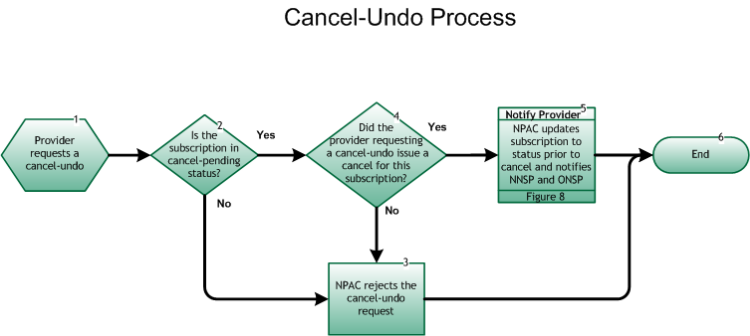- Port Type Determination Process
- Wireless ICP Process
- Broadband Verification Process
- Wireline Simple Port LSR/FOC Process
- Wireline Non-Simple Port LSR/FOC Process
- Main Porting Process
- Subscription Version Create Process
- Reseller/Interconnected VoIP Provider/Type 1 Notification Process
- Provisioning Without Unconditional 10-Digit Trigger Process
- Provisioning With Unconditional 10-Digit Trigger Process
- Conflict Flow for the Service Creation Provisioning Process
- Cancellation Flow for Provisioning Process
- Cancellation Ack Missing from New Provider Provisioning Process
- Disconnect Process for Ported TN
- Audit Process
- Code Opening Process
- First TN Ported In NPA-NXX Process
- Cancel-Undo Process

Step 1: Provider requests a cancel-undo
- The Cancel-Pending Undo Process may begin with a Service Provider requesting the reversal (undo) of an in-progress cancel for their cancel-pending port.
Step 2: Is the subscription in cancel-pending status?
- If Yes, go to Step 4.
- If No, go to Step 3.
Step 3: NPAC rejects the cancel-undo request
- NPAC sends an error to the requesting SP indicating the current SV status is not valid for a cancel-undo request.
- Go to Step 6.
Step 4: Did the provider requesting a cancel-undo issue a cancel for this subscription?
- If Yes, go to Step 5.
- If No, repeat Step 3.
Step 5: Notify Provider – NPAC updates subscription to status prior to cancel and notifies NNSP and ONSP
- Upon cancel-undo, NPAC logs this information, and changes the subscription status to the status prior to the cancel (either pending or conflict) . Both SPs are notified of the change in the subscription status via the SOA interface.
- For the notification process, refer to Inter-Service Provider LNP Operations Flows – Reseller/Interconnected VoIP Provider/Type 1 Notification, Figure 8 .
- Both SPs take appropriate action related to internal work orders.
